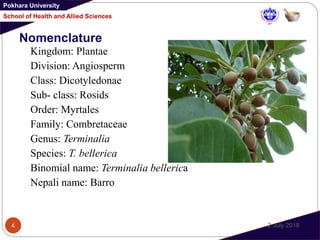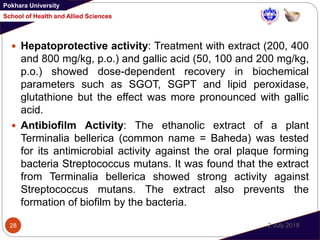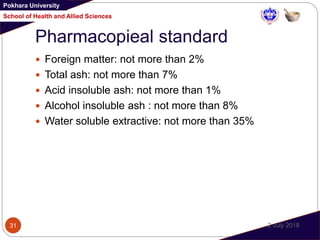8. terminalia bellerica (barro)
- 1. Shailendra shah Department of pharmaceutical science, Nobel college Pokhara University Terminalia bellerica (Barro)
- 2. Pokhara University School of Health and Allied Sciences Overview 2 July 20182 1. Nomenclature 2. Biological source 3. Habitat 4. Cultivation and collection 5. Macroscopic and microscopic character 6. References
- 3. Pokhara University School of Health and Allied Sciences Introduction 2 July 20183 Terminalia bellerica is a species of Terminalia that grows on scattered forests, sunny mountain slopes , one of the upper layer trees of stream valleys and lower seasonal rain forests, 500-1400m in the country Bangladesh, Bhutan, Cambodia, India, Indonesia, Laos, Malasiya, Myanmar, Nepal, Srilanka, Thailand, Vietnam. It is a desiduous tree growing 20-30m tall, with thick brownish grey bark having shallow longitudinal fissure.
- 4. Pokhara University School of Health and Allied Sciences Nomenclature 2 July 20184 Kingdom: Plantae Division: Angiosperm Class: Dicotyledonae Sub- class: Rosids Order: Myrtales Family: Combretaceae Genus: Terminalia Species: T. bellerica Binomial name: Terminalia bellerica Nepali name: Barro
- 5. Pokhara University School of Health and Allied Sciences Biological sources 2 July 20185 The biological sources of Terminalia bellerica are bark, leaves and fruit.
- 6. Pokhara University School of Health and Allied Sciences Habit and distribution 2 July 20186 Barro is perrenial decidious large tree up to 30cm in height commanly found in tropical and subtropical zones up to an altitude of 1500m which is mainly distributed in Nepal India and China. It is native to tropical Asia. It is common in mixed deciduous forests. It has a spreading and dome shaped crown. Distribution in Nepal: It grows in decidous forest up to the height of 1100m. Found in variety of soils clay as well as shady.
- 7. Pokhara University School of Health and Allied Sciences Cont. 2 July 20187 Cultivation Light: The tree is strong light demander. It requires direct light and cannot tolerate shade of cramped situation. The young plants however appreciate a certain amount of shade. Soil type: It grows best on fertile, loam soils with good drainage, however, it has performed reasonably well on poor soils where the choice of tree species is limited. Temperature: Average temperature ranging from 10-40⁰c is suitable for its growth. Moisture: The plant grows well on moist regions. Altitude: upto 1500m. Propagation: By fermentation of the seeds.
- 8. Pokhara University School of Health and Allied Sciences Collection 2 July 20188 Fruits are collected from the time they begins to turn yellow. They are sun dried , avoiding wetting by rain and they shrivel considerably during drying. For the extraction of tannin and the preparation of extracts the crushed are infused for 8-10 hours with hot water in a series of vats. The timber should be sawn when the wood is still green.
- 9. Pokhara University School of Health and Allied Sciences Macroscopic character 2 July 20189 Leaves: Leaves are large, glabrous, alternate, broadly elliptic to obovate- elliptical 4-24cm * 2-11cm, base rounded to cuneate, rufous-sericeous but soon glabrescent, with 6-9 pairs of secondary veins. The leaf have long petiole. Young leaves are copper red , soon becoming parrot green, then dark green. The venation of leaves is reticulate with prominent midrib. Flower: They are solitary, small 3-15 cm long, greenish white, simple, axillary spikes, calyx tube sericeous or tomentulose; flowers appear along with new leaves and have strong honey like smell.
- 10. Pokhara University School of Health and Allied Sciences Cont. 2 July 201810 Seed: The seed of Terminalia bellerica is ovoid. 5ridged and very hard. There is one stone per fruit. Fruit: The fruit of Terminalia bellerica is globose or ovoid drupe. The fruit is subsessile, grey coloured and velvety. It is 2.5 cm long and 2cm wide and it contains one stone. The fruit is slightly 5 ridged when dried.
- 11. Pokhara University School of Health and Allied Sciences Cont. 2 July 201811 Organoleptic properties: Color: Green Odor: offensive Taste: Bitter, sour, astringent and sweet.
- 12. Pokhara University School of Health and Allied Sciences Microscopic character 2 July 201812 T.S of fruit: Transverse section of the fruit shows epicarp composed of a layer of epidermal cells tangential wall and upper portion of the thick radial walls. Mesocarp, 2 or 3 layer of collenchymatous cells followed by a zone of parenchyma with fibres and sclerieids in great vascular bundles, scattered fibres, simple-pitted walls, porous parenchyma sclereids shapes and sizes, mostly elongated: tannins and aggregated crystals of calcium paenchyma; starch grains simple rounded oval in shape measuring 2-7 micrometer in size. Endocarp consists of thick walled scleroids of various shapes and sizes. Fibres, sclerieids and vessels, lignified. Testa , one layer of large cubical cells, followed by network of reticulates parenchyma and vessels; tegmen consists of collapsed parenchyma folded and containing aleuronegrains, oil globules and some rosette aggregate crystals.
- 13. Pokhara University School of Health and Allied Sciences Cont. 2 July 201813 Powder microscopy: Powder drugs show few fibres, vessels with simple pits and group of scleroids. Powdered drug is brownish in color, free flowing with granular appearance.
- 14. Pokhara University School of Health and Allied Sciences TS of fruit 2 July 201814
- 15. Pokhara University School of Health and Allied Sciences Traditional uses 2 July 201815 Fruits are laxative, astringent, anthelmintic and antipyretic; useful in hepatitis, bronchitis, asthma, dyspepsia, piles, diarrhoea, coughs, hoarseness of voice, eye diseases and scorpion-sting; used as a hair tonic. Decoction of the green fruit is used for cough. Pulp of the fruit is useful in dysenteric-diarrhoea, dropsy, piles and leprosy. Half ripe fruit is used as purgative. Kernel of the fruit is narcotic. Fruits are used in menstrual disorder in Khagrachari. Seed oil is used in rheumatism. Gum of the bark is demulcent and purgative. The triterpenoid present in the fruits possess significant antimicrobial activity. Kernel oil has purgative action and its prolonged use was well tolerated in mice.
- 16. Pokhara University School of Health and Allied Sciences 2 July 201816 Fruit powder is taken with water to cure cough in dhading district. Seeds are boiled, dried, pulverized and smoked by Tharus of Chitwan district. Fruit Pulp is used in chronic diarrhea, dysentery flatulence, vomiting nad urinary disorder at Palpa district. Powdered fruit is used by the Limbu’s of Morang district in ulcer.
- 17. Pokhara University School of Health and Allied Sciences Modern Medicinal Uses 2 July 201817 Central nervous system: improves vision and nourish brain and nerves. Respiratory system: it is used in Dyspnea, asthma and whooping cough Digestive system: is used in constipation, abdominal pain and distention, foul feces and breath, Flatulence, weakness and slow pulse. Skin: A fine paste of powder may be applied on burns and scalds.
- 18. Pokhara University School of Health and Allied Sciences Phytoconstituents 2 July 201818 Glycoside (bellericanin), Gallo-tannic acid, Coloring matter, resins and a greenish yellow oil. Ellagic acid, gallic acid, lignans (termilignan and thannilignan), 7- hydroxy 3’4’ (methylenedioxy) flavone and anolignanB. Tannins, ellagic acid, ethyl gallate, galloyl glucose and chebulagic acid, phyllemblin, β-sitosterol, mannitol, glucose, fructose and rhamnose.
- 19. Pokhara University School of Health and Allied Sciences Cont. Gallgic acid Ethyl gallate 2 July 201819
- 20. Pokhara University School of Health and Allied Sciences Chebulagic acid Tannic acid 2 July 201820
- 21. Pokhara University School of Health and Allied Sciences Pharmacological effects 2 July 201821 Analgesic activity Anti diarrhoeal activity Antioxidant activity Antihypertensive effect Anti salmonella activity Anti- Spasmodic and Bronchodilatory properties Anti-micobial activity Antimicrobial and Toxicity studies Wound healing activity Immmunological activity Acute and sub acute toxicities Immune response in vitro Hepatoprotective activity Antibiofilm Activity Antiulcer activity Antipyretic activity Antimutagenic actvity Antithrombotic and thrombolytic activity
- 22. Pokhara University School of Health and Allied Sciences 2 July 201822 Analgesic: The crude extract of Terminalia bellerica contain analgesic activity at the dose range of 300-1000mg/kg inhibited the castor oil induced intestinal fluid secretion in mice. The extract also dose-dependently (50 - 100 mg/kg) where it reduced the numbers of acetic acid-mediated in mice. These results indicate that TB exhibit antisecretory and antinociceptive effects, hence justifying its medicinal use in diarrhea and pain.( Khan AU etal 2008) Anti diarrheal activity: The Antidiarrhoeal activity was perfomed using Castor oil induced diarrhea. Aqueous and ethanolic extract of fruit pulp of Terminalia bellerica at the doses of 334 mg/kg, 200mg/kg, 143mg/kg were used.
- 23. Pokhara University School of Health and Allied Sciences 2 July 201823 Antihypertensive Effect: After administration of Terminalia bellerica, they observed that fall in the arterial BP of rats under anaesthesia. In isolated guinea-pig atria, inhibition of force and rate of atrial contractions noted. In rabbit thoracic aorta, relaxation was observed after the induction of contractions which was induced by phenylephrine.
- 24. Pokhara University School of Health and Allied Sciences 2 July 201824 Antimicrobial study: The Aqueous extract of dry fruit at 4 mg concentration showed highest zone of inhibition against S.aureus. These pathogens were highly sensitive to the methanol extract also except E. coli (enteropathogen) and P. aeruginosa. Terminalia bellerica dry fruit possesses potential broad spectrum antimicrobial activity. Antimicrobial and Toxicity Studies: The crude methanolic extract of the fruits of Terminalia bellerica Roxb along with its various organic fractions elicited both in vitro and in vivo antioxidant activity as well as antibacterial activity. Total antioxidant activity, scavenging free radical, authentic peroxynitrite and reducing power assessment were performed.
- 25. Pokhara University School of Health and Allied Sciences 2 July 201825 Antioxidant activity: The crude aqueous extract of the fruits of Terminalia bellerica Roxb have antioxidant properties since these contains enzymatic and non – enzymatic antioxidants, these can be very effective against microbes causing various diseases. In vitro assessment of the antioxidant activity of ethanolic fractions of both these plants to scavenge 2, 2- Diphenyl-1-picrylhydrazyl (DPPH) and highly reactive hydroxyl radicals showed that the semi pure compounds present in the fractions are useful potential source of antioxidants and can be used in the therapy of diseases like cancer, coronary heart disease, ageing and any other disease related to oxidative stress. These fractions being non-toxic showed significant antioxidant activity at scavenging free radicals damage.
- 26. Pokhara University School of Health and Allied Sciences 2 July 201826 Wound healing activity: The paste of Terminalia bellerica Roxb have proper efficacy on wound healing. Herbal paste preparation showed significant improvement on maturation, wound contraction and epithelialization. Immunological activity: T. bellerica extract affected T cell proliferation mainly through the same mechanism as PHA. The extract with LPS and PWM also affected B cell proliferation through T cell-independent and T cell dependent mechanisms respectively. The results indicated that the extract affected cellular mediated immunity (CMI) rather than humoral mediated immunity (HMI).
- 27. Pokhara University School of Health and Allied Sciences 2 July 201827 Acute and Sub-acute Toxicity: Single oral administration of the ethanolic extract of T. belerica at a dose of 5,000 mg/kg did not produce any toxicity. In sub-acute toxicity, repeated administration of 1,000 mg/kg of T. bellerica over 14 days did not cause changes in terms of general behaviors, mortality, weight gain, hematological or clinical blood chemistry parameters. The results of histological examinations showed normal appearance of the internal organs when compared to those of the control group. Immune response In vitro: In vitro Phagocytic activity and lymphocyte proliferation assay were carried out in methanolic extract of on the mouse immune system. In both assay, stimulation of macrophage phagocytosis and maximal activation of phytohemagglutinin were observed.
- 28. Pokhara University School of Health and Allied Sciences 2 July 201828 Hepatoprotective activity: Treatment with extract (200, 400 and 800 mg/kg, p.o.) and gallic acid (50, 100 and 200 mg/kg, p.o.) showed dose-dependent recovery in biochemical parameters such as SGOT, SGPT and lipid peroxidase, glutathione but the effect was more pronounced with gallic acid. Antibiofilm Activity: The ethanolic extract of a plant Terminalia bellerica (common name = Baheda) was tested for its antimicrobial activity against the oral plaque forming bacteria Streptococcus mutans. It was found that the extract from Terminalia bellerica showed strong activity against Streptococcus mutans. The extract also prevents the formation of biofilm by the bacteria.
- 29. Pokhara University School of Health and Allied Sciences 2 July 201829 Antiulcer Activity: The anti-ulcer activity of ethanolic extract of Terminalia bellerica (Combretaceae) fruits ETB was investigated in pylorus ligation and ethanol induced ulcer models in wistar rats. ETB at doses of 250-500 mg/kg orally produced significant inhibition of the gastric lesions induced by Pylorus ligation induced ulcer & Ethanol induced gastric ulcer. The extract (250 mg/kg & 500 mg/kg) showed significant reduction in free acidity and ulcer index as compared to control. Antithrombotic and thrombolytic activity: An in vitro model was used to check the clot lysis and antithrombotic effect of Terminalia bellerica fruits along with Streptokinase as a positive control.
- 30. Pokhara University School of Health and Allied Sciences 2 July 201830 Antipyretic Activity: The antipyretic activity of ethanolic and aqueous extracts of Terminalia bellirica fruits (200 mg/kg, p.o.) was studied in brewer's yeast-induced fever models in mice and rats. Both extracts showed a significant inhibition of elevated body temperature when compared to corresponding control. Antimutagenic Activity: Water, acetone, and chloroform extracts of Terminalia bellerica were examined for their antimutagenic potency using the Ames Salmonella/microsome assay. Acetone extract exhibited variable inhibitory activity of 65.6%, and 69.7% with 4- Onitrophenylenediamine (NPD) and sodium azide, respectively (as direct-acting mutagens), and 81.4% with 2- aminofluorene (2AF) (an S9-dependent mutagen), in the preincubation mode of experimentation.
- 31. Pokhara University School of Health and Allied Sciences Pharmacopieal standard 2 July 201831 Foreign matter: not more than 2% Total ash: not more than 7% Acid insoluble ash: not more than 1% Alcohol insoluble ash : not more than 8% Water soluble extractive: not more than 35%
- 32. Pokhara University School of Health and Allied Sciences Formulations 2 July 201832 Indian Ayurvedic formulation Triphala used for treatment of digestive and respiratory disease. Bibhitaki powder which is used for hair, throat and eyes related problems
- 33. Pokhara University School of Health and Allied Sciences 2 July 201833 Adverse reaction: no information noted Contraindication: Hypersensitivity or allergy to the plant material and in pregnancy.
- 34. Pokhara University School of Health and Allied Sciences References 2 July 201834 1. Terminalia bellirica URL-1: https://en.wikipedia.org/wiki/Terminalia_bellirica (accessed on 12th June 2018) URL-2: http://www.pitchandikulam- herbarium.org/contents/description-habit.php?id=50 (accessed on 12th june 2018) 2. Deb A, Barua S, Dr Das B(2016) Pharmacological activities of Terminalia berellica: A review. Journal of pharmacognosy and phytochemistry pp(194-197)
- 35. Pokhara University School of Health and Allied Sciences 2 July 201835



































